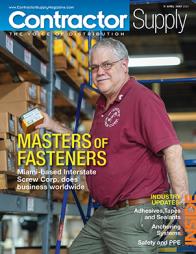STAFDA Inventory Consultant: The Triangle of Cooperation
Success requires a team effort from sales, purchasing and the warehouse.
 |
 |
Most manufacturers and distributors want to achieve the goal of effective inventory management: “Effective
Inventory Management allows a company to meet or exceed customers’ expectations of product availability with the amount of each item that will maximize net profits or minimize the organization’s total inventory investment.”
But whose responsibility is it to accomplish this goal? Often it is left to one person or department. But we have found that effective inventory management takes support and acceptance of responsibility by sales, purchasing/
replenishment and warehouse personnel. We refer to this as the “triangle of cooperation.”
Without the active participation of each of the triangle’s sides achieving effective inventory management is impossible. In this article we will discuss specific responsibilities for salespeople, purchasing or replenishment and warehouse people and how each department must cooperate in a joint effort to maximize the productivity and profitability of your investment in stock inventory.
The Role of the Salesperson
I have heard many salespeople say, “The only thing I know about inventory is we never have enough of it. I can’t sell out of an empty wagon.” These folks do not work for successful organizations. In a “best practice” company salespeople take an active role in inventory planning. Their responsibilities include:
- Determining what products should be stocked in each branch or warehouse. Salespeople should be in almost constant communications with customers. They are probably in the best position to determine what you must have in inventory to meet your customer’s expectations. That doesn’t mean that you must carry anything and everything that a customer might ask for someday. It does mean that your customers’ impression should be that your inventory better meets their needs than the stock of your competitors.
- Helping to develop the forecast of future sales of each product. Your salespeople are also in the best position to observe your customers’ changing needs over time. They should help determine why there was a large discrepancy between a forecast and what was actually sold in a specific week or month. For example, why did a customer buy an unusually large quantity of an item? Will this be a new ongoing requirement or was it a one time only sale? Studying unusual sales activity can provide salespeople with valuable information for increasing future sales!
- Helping keep inventory records accurate. Salespeople are usually very empathetic with their customers. They often will go to great lengths to meet a customer’s needs. However, they must follow your established rules for properly recording all material disbursements. For example, salespeople should not take material out of a warehouse without properly recording it in your computer system.
The Role of Purchasing/Replenishment
After listening to their responsibilities, many salespeople might feel that they are doing all of the work involved in replenishing inventory. But your buyers have an equally important role in the success of your company. They have to make sure that inventory is available to meet the sales or usage forecast. While accomplishing this primary and most important goal, buyers must replenish stock in such a way as to minimize the “total cost” of each piece. If you minimize your total cost of inventory, you will maximize your profits!
Decisions involved in minimizing the total cost of inventory include:
- Deciding the best source of supply for each product in each stocking location. Do you buy it, if so from what vendor? Are replenishment quantities transferred from a central warehouse or distribution center? Do you assemble a product from component parts in this warehouse?
- Determining the economic order quantity for each product. The economic order quantity (i.e., EOQ) balances the cost of the material with the carrying cost of inventory and the cost of issuing and receiving replenishment orders.
The Role of Warehouse Personnel
Warehouse people make up the third side of the triangle of cooperation. However they often, like the late comedian Rodney Dangerfield, get no respect. Everyone must realize the vital role they play in your company’s success. You might have an accurate forecast and buy your inventory at the lowest total cost; but if it is lost, stolen or destroyed, you can’t meet your customers’ expectations. Warehouse people must:
- Organize stock in the warehouse to minimize the cost of filling orders. After all, you ship material far more frequently than you receive it. It makes sense to store material to maximize the efficiency of the order fulfillment process.
- Keep inventory records accurate. If the quantity in the computer system does not agree with what is in the warehouse, salespeople won’t know what is available for sale and buyers will not replenish inventory at the right time. This task probably will involve conducting full physical inventories or cycle counting certain products each day.
- Ensure that all material movement (both receipts and disbursements) are properly recorded. This will ensure that quantities in your warehouse remain accurate. After all, you can have an accurate forecast and bring material in such a way to minimize your total cost. But if it isn’t properly recorded in your computer system, you will probably experience problems such as:
- Bringing in unnecessary stock because previous stock receipts weren’t correctly posted and you have actually had more inventory than your system reports.
- Unexpected stockouts due to unrecorded material disbursements, substitutes, damaged parts and other “sloppy” procedures.
- Protect inventory from breakage, spoilage, misplacement and theft. Inventory is valuable and all employees must realize that their paychecks result from the sale of inventory. If inventory is “lost,” it must be paid for out of the company’s profits. This means that fewer profit dollars are available to pay employees.
Achieving effective inventory management is probably one of the most effective undertakings to increase your company’s profitability. But it cannot be accomplished by just one person or department. It takes cooperation and commitment from everyone
in sales, purchasing and the warehouse. You must implement and maintain the “triangle of cooperation and responsibility.” CS
Jon Schreibfeder is president of Effective Inventory Management, Inc. He has authored numerous articles and several books on inventory management best practices and is the designated inventory management consultant for STAFDA. Jon can be reached at 972-304-3325 or by e-mail at info@effectiveinventory.com















